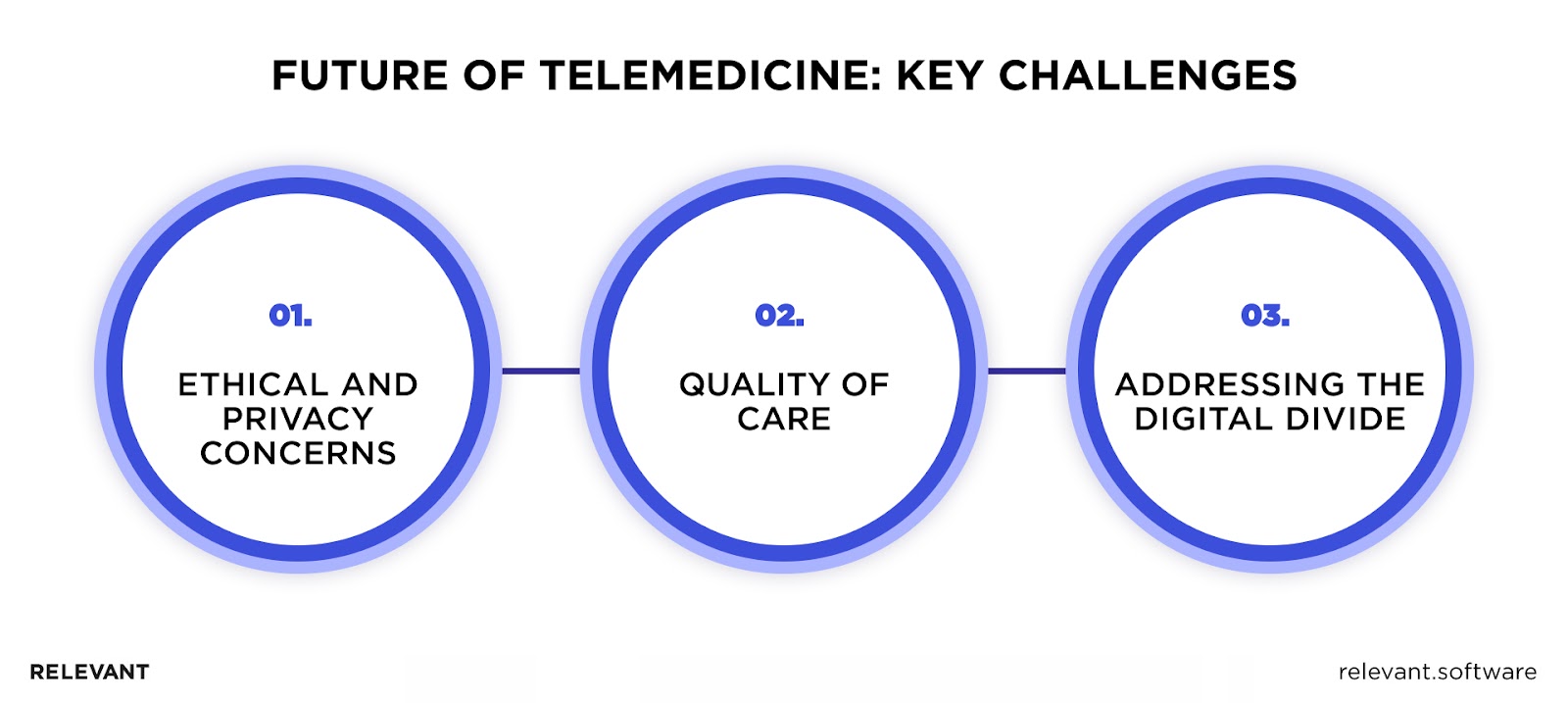Future of Telemedicine: What's on the Horizon?

As we glimpse into the forthcoming future of telemedicine, we’re not just witnessing the evolution of technology but a comprehensive reimagining of healthcare delivery. During the COVID-19 pandemic, the use of telemedicine has surged as a means of circumventing strict limitations on outpatient visits and hospital access.
As is often the case, pressing demands—in this case, the need to provide continuity of personalized care for patients with chronic conditions who are unable to postpone appointments—have catalyzed the rapid development and adoption of telemedicine and telehealth solutions. The digital consultation rooms and virtual clinics are just the tip of the iceberg; beneath the surface lies a wealth of opportunities for predictive healthcare, individualized treatment plans, and a globally connected healthcare network.
However, this future vision of telemedicine is not without its challenges and uncertainties. How will regulatory frameworks evolve to keep pace with digital healthcare? How will telemedicine integrate with new technologies to ensure quality and continuity of care? These are the questions we will explore as we delve deeper into the anticipated advancements and potential roadblocks in the journey to the telemedicine future.
Evolution of Telemedicine
If you’ve had a video consultation with your doctor, you’ve engaged with telemedicine, a practice with deeper historical roots than one might assume. Going back to 1879, a Lancet article discussed using telephones to reduce unnecessary doctor visits. The advent of radio technology in the 1900s opened new possibilities in healthcare, hinting at a future where video calls between doctors and patients were commonplace.
The first practical stride in telehealth occurred in 1940s Pennsylvania, where radiology images were sent 24 miles between towns, marking the first electronic medical record transfer. This initiative was further developed by a Canadian doctor in the following decade, establishing a functional teleradiology system around Montreal. The emergence of motion picture technology further catalyzed the evolution of video medical communication, with the University of Nebraska establishing a two-way television system in 1959 for educational purposes and, later, video consultations.
Today, telehealth is vital, particularly in remote areas with limited healthcare access—a key focus of the University of Nebraska’s research. By the 1960s, telemedicine was making inroads into urban environments, exemplified by a 1967 collaboration between the University of Miami School of Medicine and the local fire department to transmit critical medical data during emergencies, integrating telemedicine into urban healthcare solutions.
Present and Future Benefits of Telemedicine
Today, telemedicine is about face-to-face video consultations, discussing symptoms, and even getting prescriptions, all without leaving your couch. Telehealth devices echo their predecessors in form, but they are notably more compact and feature-rich. Let’s revisit some of the primary benefits of telemedicine:
- Cost-effective healthcare due to efficient resource and staff management.
- Primary caregivers can offer consultations without the need for extra office staff.
- A decrease in missed appointments since virtual visits are possible even if in-person visits aren’t feasible.
- Remote care consultations eliminate the need for distant travel, especially for those lacking convenient transportation or those too ill to journey.
- Rural clinics can consult with specialty providers as needed, addressing the challenges faced by the 60 million Americans in Health Professional Shortage Areas.
- Daily monitoring is possible for the numerous Americans living with chronic illnesses, enhancing their quality of life at home.
- Immediate issue resolution via telemedicine often reduces hospital stays, transfers, and readmissions.
- Alleviates the impact of healthcare professional shortages.
- Modern digital technology not only advances medical care services quality but also augments preventive measures, subsequently enriching life quality and reducing mortality rates.
Read our blog article to learn more about how telemedicine works.

Technological Advancements Shaping the Future of Telemedicine 2023
As this integration between telemedicine and technology grew, the healthcare landscape was poised for a significant transformation. Let’s talk about which technologies are seriously reshaping telemedicine.
The Integration of AI and ML in Healthcare
Representing a profound analytical prowess, AI facilitates precise and comprehensive diagnostic tools, ensuring reliable analysis results. Concurrently, Machine Learning customizes treatments, meticulously adapting to the unique needs of each patient. The emergence of chatbots and virtual health assistants further guarantees consistent and immediate support for patients, addressing their queries with efficiency.
The forthcoming advancements in AI technology are designed to facilitate the incorporation of an extensive array of health data into medical systems, helping to identify patterns that indicate possible complications.
For instance, these advanced systems are capable of monitoring daily variations in blood pressure and glucose levels. Regularly assessing a patient’s temperature as they’re recovering at home after surgery enables prompt medical attention if an infection is detected. These sophisticated functionalities are particularly advantageous for individuals residing in remote areas, where conducting in-person follow-up appointments entails substantial travel.
Implications of 5G and IoT on the Future of Telemedicine
5G technology introduces unprecedented connectivity, promising seamless and real-time communication between healthcare providers and patients. When integrated with the Internet of Things (IoT), a network of interconnected devices that diligently collect essential health data, a powerful health monitoring system emerges. The synergistic application of these advanced technologies heralds innovative possibilities to facilitate enhanced quality of healthcare from a distance.
Individuals at home can utilize wearables and varied medical tools to monitor their vitals, such as blood pressure, temperature, and heart rate, subsequently transmitting this data for their physician’s analysis. Healthcare practitioners can record patient notes, prescribe medications, and input additional information accessible by pharmacists and specialists in disparate locations.
These interconnected wearables consistently monitor patient vitals, relaying the information to cloud-based platforms for continuous assessment by both patients and healthcare providers. Such continuous monitoring aids individuals with chronic ailments in better self-management of their conditions, potentially reducing the necessity for urgent care and visits to the emergency department. Should patients experience discomfort or have inquiries, they possess the convenience of arranging a telemedicine consultation, during which healthcare providers can review the accumulated data to offer informed advice.

Incorporation of VR and AR in Medical Practice
No longer confined to the realms of entertainment, Virtual Reality (VR) and Augmented Reality (AR) have become pivotal in medical education and patient care. These technologies offer medical students a virtual environment for practicing surgical procedures without risk and have enriched the interactive nature of patient consultations. Imagine a scenario where a physician, utilizing AR, provides virtual assistance during a patient’s self-examination, thereby enhancing the depth and immersive quality of the consultation.
In summary, the advancements we observe in telemedicine, from the precision of AI to the communicative enhancements brought about by 5G and IoT and the immersive experiences afforded by VR and AR, are indicative of a future where telemedicine is characterized by innovation and refined healthcare delivery.
The New Phase of Telemedicine in the Aftermath of COVID-19
It wasn’t too long ago that many professionals looked at digital solutions with a mix of doubt and curiosity. Then COVID-19 came along, turning the world upside down and, with it, our entire health system. It’s quite astonishing how this pandemic worked as a rapid accelerator for digital health solutions, especially telemedicine.
Just to put things in perspective, a couple of years ago, there were forecasts by the Everest Group about healthcare providers increasing their digital IT spending by 15% around the year 2025. With the pandemic’s unexpected entry, those figures have doubled. Not just a slight adjustment but a rather swift turn towards higher investment and in a much shorter timeframe.
Reflecting on the future of telemedicine in post-COVID life, this isn’t a passing trend. We are likely seeing the genesis of a robust, more holistic healthcare approach. Beyond just addressing pandemic needs, telemedicine now promises a wider range of healthcare delivery, particularly for those in remote areas or with limited mobility.
Also, the rise of independent telemedicine platforms indicates an exciting shift. It feels like we’re heading towards a world where healthcare is more than just scheduled visits to a clinic. It’s becoming more about timely care, personal choice, and immediate connectivity.
Future of Telemedicine: Potential Challenges and Solutions
Telemedicine has the potential to reshape healthcare, especially as we adapt to life post-COVID. But, like any good story, it’s not without its challenges. Let’s dive into what lies ahead, particularly focusing on 2024 and beyond.

Ethical and Privacy Concerns
Dealing with people’s health means handling a lot of private data. How do we keep it safe? And it’s not just about locking away information – people need to feel their privacy is being respected. It’s fundamental. Ensuring clear consent and transparency is like building trust in any relationship – it’s a must. Patients should always know where their data goes and for what purpose.
Quality of Care
Quality isn’t just a fancy word – it’s the backbone of healthcare. So, making sure telemedicine platforms uphold the same standards is a big deal. We can’t just overlook a misdiagnosis or a tech hiccup; addressing these issues is key. Whether it’s a simple consultation or an intricate diagnosis, the standard of care shouldn’t waver. The future of independent telemedicine relies heavily on maintaining this quality.
Addressing the Digital Divide
Technology is brilliant, but it’s not available everywhere. There are places where the Internet is still a luxury. So, how do we ensure everyone gets access to telehealth? It’s all about inclusivity and finding ways to bridge the digital divide about telemedicine. The future of healthcare telemedicine is dependent on making it accessible to everyone, not just those with the latest gadgets.
Peeking Into the Next Decade: What is the Future of Telemedicine?
Addressing the question of how telemedicine will impact the future of healthcare requires an understanding of its current trajectory. Telemedicine is swiftly becoming a fundamental pillar, ensuring that geographical barriers no longer dictate the quality of care a patient receives. This is especially noticeable in regions where there are not enough specialized medical specialists.
Hybrid Models: A Happy Middle Ground
We’re seeing a trend where the convenience of virtual care and the intimacy of in-person interactions are coming together. It’s about merging the best of both worlds, creating a healthcare experience that’s both practical and personal. This synergy is shedding light on why telemedicine is the future of the healthcare industry.
Automation on the Rise: The Future of Telemedicine Platforms
There’s quite a bit of buzz around the development of automated telemedicine platforms. Imagine a system where preliminary consultations and patient data collection happen with minimal human intervention—this means healthcare professionals can focus their attention where it’s needed most, improving overall efficiency.
Shifting Away from Reimbursement Models
Historically, reimbursement served as the conventional method for financing telemedicine, yet this approach is anticipated to evolve. Health system performance has expanded beyond independent physicians and institutions, which are now controlled primarily by organizations such as accountable care organizations and managed care groups.
Managed care currently covers more than seventy million people in the United States, representing almost a quarter of the population. As the decision-making processes continue to decentralize from local patients, the necessity for transmitting medical data escalates. Consequently, this development is expected to integrate telemedicine costs into the general overhead of medical expenses rather than categorizing them as distinct reimbursable items.
When we think about the future benefits of telemedicine, it’s all about accessibility, personalized care, cost-efficiency, and putting the patient’s needs front and center. Telemedicine is paving the way for a healthcare system that harmoniously blends tech innovation with a human touch.
Future of Telemedicine: Final words
So, what is the future of telemedicine, where’s it heading? Everywhere, it seems. It’s making healthcare more accessible, more personalized, and in many cases, more human. It’s fascinating to see where we started and even more exciting to think about where we’re going. The market, valued at $3 billion, has the potential to expand to a staggering $250 billion, according to McKinsey. The foundation for prosperity is laid out—now it’s your move.
Should you wish to participate in this global movement by developing a telemedicine application that connects doctors and patients, consider reaching out to Relevant healthcare software development. We offer thorough evaluations and software IT consultations, allowing us to determine the best approach to realize your vision collaboratively. Contact us!



